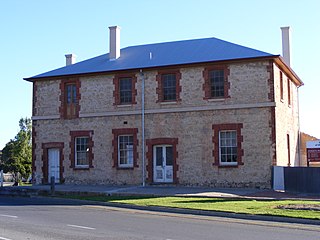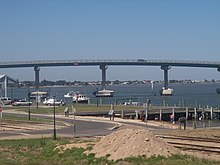The Kaurna people are a group of Aboriginal people whose traditional lands include the Adelaide Plains of South Australia. They were known as the Adelaide tribe by the early settlers. Kaurna culture and language were almost completely destroyed within a few decades of the British colonisation of South Australia in 1836. However, extensive documentation by early missionaries and other researchers has enabled a modern revival of both language and culture. The phrase Kaurna meyunna means "Kaurna people".
Keith Windschuttle is an Australian historian. He was appointed to the board of the Australian Broadcasting Corporation in 2006. He was editor of Quadrant from 2007 to 2015 when he became chair of the board and editor-in-chief. He was the publisher of Macleay Press, which operated from 1994 to 2010.
The Fleurieu Peninsula is a peninsula in the Australian state of South Australia located south of the state capital of Adelaide.

The Ngarrindjeri people are the traditional Aboriginal Australian people of the lower Murray River, eastern Fleurieu Peninsula, and the Coorong of the southern-central area of the state of South Australia. The term Ngarrindjeri means "belonging to men", and refers to a "tribal constellation". The Ngarrindjeri actually comprised several distinct if closely related tribal groups, including the Jarildekald, Tanganekald, Meintangk and Ramindjeri, who began to form a unified cultural bloc after remnants of each separate community congregated at Raukkan, South Australia.
Hindmarsh Island is an inland river island located in the lower Murray River near the town of Goolwa, South Australia.

Goolwa is a historic river port on the Murray River near the Murray Mouth in South Australia, and joined by a bridge to Hindmarsh Island. The name "Goolwa" means "elbow" in Ngarrindjeri, the local Aboriginal language, and the area was known as "The Elbow" to the early settlers.
Dr Ron Brunton is an Australian anthropologist. He was the director of Encompass Research Pty Ltd, and was on the Board of the public broadcaster, the Australian Broadcasting Corporation (ABC) for a five-year term from 1 May 2003.

Makassar people from the region of Sulawesi in Indonesia began visiting the coast of Northern Australia sometime around the middle of the 18th century, first in the Kimberley region, and some decades later in Arnhem Land. They were men who collected and processed trepang, a marine invertebrate prized for its culinary value generally and for its supposed medicinal properties in Chinese markets. The term Makassan is generally used to apply to all the trepangers who came to Australia.

The Hindmarsh Island bridge controversy was a 1990s Australian legal and political controversy that involved the clash of local Aboriginal Australian sacred culture and property rights. A proposed bridge to Hindmarsh Island, near Goolwa, South Australia attracted opposition from many local residents, environmental groups and indigenous leaders. In 1994, a group of Ngarrindjeri women elders claimed the site was sacred to them for reasons that could not be revealed. The case attracted much controversy because the issue intersected with broader concerns about Indigenous rights, specifically Aboriginal land rights, in the Australian community at the time, and coincided with the Mabo and Wik High Court cases regarding Native title in Australia.
The Bennelong Society was a conservative think-tank dedicated to Indigenous Australian affairs. The society was named after the Eora man, Bennelong, who served as an interlocutor between the Indigenous Australian and British cultures, both in Sydney and in the United Kingdom almost from the start of British settlement of Australia in 1788. It was affiliated with conservative commentators in debates on Indigenous affairs. The society was established to:
Diane Robin (Di) Bell is an Australian feminist anthropologist, author and activist. She is Professor Emerita of Anthropology at the George Washington University in Washington, D.C, USA and Distinguished Honorary Professor of Anthropology at the Australian National University, Canberra. Her work focuses on the Aboriginal people of Australia, Indigenous land rights, human rights, Indigenous religions, violence against women, and on environmental issues.

William Ramsay Smith, frequently referred to as Ramsay Smith, was a Scottish physician, educator, naturalist, anthropologist and civil servant, who worked in South Australia after moving there at the age of about 37 in 1896. He was initially appointed as a pathologist at the Royal Adelaide Hospital and was later appointed to other roles, including that of city coroner in Adelaide, but his legacy has been marred by allegations of misuse of human remains. He made a study of Aboriginal Australians, and sent body parts to Edinburgh University's anthropological collection. He published a number of books and articles in scientific journals, and in 1930 published a work under his own name which was later found to be the work of Ngarrindjeri Elder David Unaipon.

Clayton Bay is a town in South Australia located on Lake Alexandrina and Lower Murray River, part of the lower lakes and Coorong region at the end of the Murray River System. The town is located north of the north-east tip of Hindmarsh Island about 87 kilometres (54 mi) from Adelaide and 30.7 kilometres (19 mi) by road from Goolwa.

The Forrest River massacre, or Oombulgurri massacre, was a massacre of Indigenous Australian people by a law enforcement party in the wake of the killing of pastoralist Fred Hay, which took place in the Kimberley region of Western Australia in 1926. The massacre was investigated by the Woods Royal Commission in 1927 which subsequently determined that 11 people had been killed. Charges were brought against two officers but dismissed for lack of evidence. The Commissions findings have been disputed by journalist Rod Moran, whose analysis has received some academic support while most academic historians accept that a massacre did take place but disagree over the number of victims.

John William von Doussa is a former Australian judge and public servant. He was a judge of the Federal Court of Australia from 1988 to 2003, president of the Human Rights and Equal Opportunity Commission from 2003 to 2008, and chancellor of the University of Adelaide from 2004 to 2010.

Raukkan is an Australian Aboriginal community situated on the south-eastern shore of Lake Alexandrina in the locality of Narrung, 80 kilometres (50 mi) southeast of the centre of South Australia's capital, Adelaide. Raukkan is "regarded as the home and heartland of Ngarrindjeri country."
Doreen Maude Kartinyeri was an Ngarrindjeri elder and historian, born in the Australian state of South Australia. She played a key role in the Hindmarsh Bridge controversy and made many contributions to Indigenous activism.
The Tanganekald people were or are an Aboriginal Australian people of South Australia, of the Ngarrindjeri nation.

The Nauo people, also spelt Nawu and Nhawu, are an Aboriginal Australian people of the south-western Eyre Peninsula in South Australia. The Nauo language became extinct by the twentieth century, but efforts are being made to revive it.
Yvonne Koolmatrie is an Australian artist and weaver of the Ngarrindjeri people, working in South Australia.










